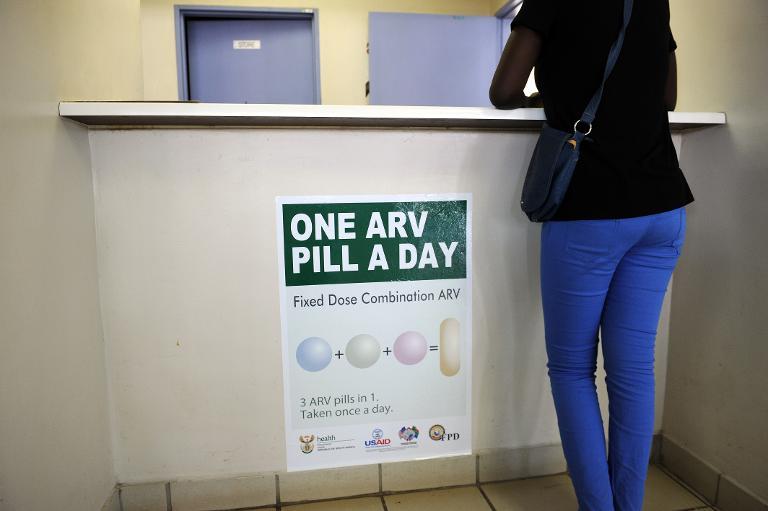
A woman queues at a clinic on April 8, 2013 during the launch of the new single dose anti-AIDs drug, in Ga-Rankuwa, South Africa(Agencies)
|
The number of adolescents infected by the HIV virus has jumped by one third over the past decade, the UN's health agency said Monday, blaming gaps in care programmes. "More than 2 million adolescents between the ages of 10 and 19 years are living with HIV," marking a 33 percent rise since 2001, the World Health Organization said. "Many do not receive the care and support that they need to stay in good health and prevent transmission. In addition, millions more adolescents are at risk of infection," it warned. In the world's most AIDS-affected region, sub-Saharan Africa, the majority of adolescents with the virus are girls who have had unprotected sex, sometimes under duress. In addition, many of those born with the virus or infected at birth in sub-Saharan Africa are becoming adolescents. In Asia, meanwhile, young drug-users were the worst affected. The WHO said that the failure to provide proper adolescent-focussed programmes had also resulted in a 50-percent increase in reported AIDS-related deaths in the age group from 2005 to 2012. In 2005, 70,000 adolescents died of AIDS. Seven years later, the figure was 104,000. That contrasted starkly with the 30-percent decline in the general population, the WHO underlined. The year 2005 marked the high point of global AIDS deaths, which hit 2.3 million. Last year, the toll was 1.6 million. "Adolescent girls, young men who have sex with men, those who inject drugs or are subject to sexual coercion and abuse are at highest risk," said Craig McClure, head of HIV programmes at UN children's agency UNICEF. "They face many barriers, including harsh laws, inequalities, stigma and discrimination which prevent them from accessing services that could test, prevent, and treat HIV," McClure added. "About one-seventh of all new HIV infections occur during adolescence. Unless the barriers are removed, the dream of an AIDS-free generation will never be realised," he insisted. The data was issued as the WHO released its first adolescent-specific care guidelines ahead of World AIDS Day on December 1. "Adolescents face difficult and often confusing emotional and social pressures as they grow from children into adults," said Gottfried Hirnschall, head of the WHO's HIV/AIDS Department. "Adolescents need health services and support, tailored to their needs. They are less likely than adults to be tested for HIV and often need more support than adults to help them maintain care and to stick to treatment," he added. Among the measures needed, the WHO said, is an end to the requirement for parental permission to have an HIV test. In sub-Saharan Africa, it is estimated that in the 15-24 age bracket, only 10 percent of young men and 15 percent of young women know their HIV status. In other regions, although data are scarce, access to HIV testing and counselling by vulnerable adolescents is consistently reported as being very low, the WHO said. |
據(jù)法國(guó)媒體報(bào)道,世界衛(wèi)生組織11月25日宣布,過去十年間感染艾滋病病毒的青少年人數(shù)增加了33%,2012年全世界10到19歲的青少艾滋病病毒感染人數(shù)約為210萬。 該組織警告說:“很多人并沒有受到保持健康和阻止傳播所需要的關(guān)懷和支持。此外,另有數(shù)百萬名青少年面臨感染艾滋病的風(fēng)險(xiǎn)。”由于相關(guān)服務(wù)項(xiàng)目的缺乏,在2005年到2012年間,青少年中艾滋病死亡人數(shù)增長(zhǎng)了近50%,從2005年的7萬升到2012年的10.4萬。與此形成鮮明對(duì)比的是,同期全球艾滋病死亡人數(shù)下降了30%,從2005年的230萬降至2012年的160萬。 更糟糕的是,很多人并不清楚自己是否患上了艾滋病。撒哈拉以南非洲15到24歲年齡段人群中,只有10%的男性和15%的女性知道自己的感染狀況。 聯(lián)合國(guó)兒童基金會(huì)艾滋病項(xiàng)目負(fù)責(zé)人克雷格?麥克盧爾說:“青春期女孩,與同性發(fā)生性行為的年輕男子,注射毒品者,以及遭受性壓迫和性虐待的人是高風(fēng)險(xiǎn)人群。他們面臨嚴(yán)苛的法律、不平等、污名、歧視等障礙,這些障礙讓他們無法獲得檢測(cè)、預(yù)防和治療艾滋病的服務(wù)。”因此他認(rèn)為,必須清除這些障礙。 世界衛(wèi)生組織在1988年將每年的12月1日定為世界艾滋病日,號(hào)召世界各國(guó)和國(guó)際組織在這一天舉辦活動(dòng),宣傳和普及預(yù)防艾滋病知識(shí)。目前,該組織已經(jīng)發(fā)布了一份針對(duì)青少年艾滋病病毒感染者及有感染風(fēng)險(xiǎn)者防控特殊需求的指導(dǎo)意見,意圖加強(qiáng)為該群體提供的服務(wù)和支持。 相關(guān)閱讀 英國(guó)能源巨頭誤將15萬英鎊打入一業(yè)余演員賬戶 新加坡、韓國(guó)為“五眼”間諜聯(lián)盟伙伴國(guó) 協(xié)助監(jiān)聽亞洲海底通訊電纜 6種不該在這個(gè)假日季購(gòu)買的電子產(chǎn)品 (信蓮 編輯:玉潔) |
